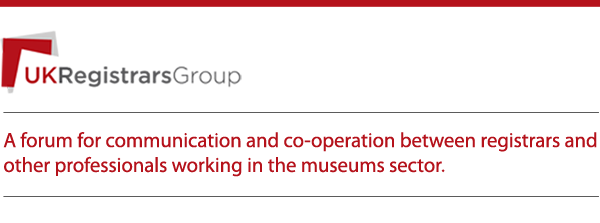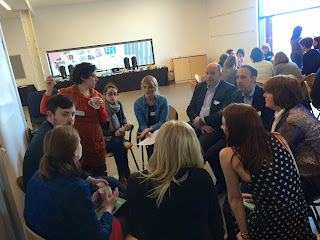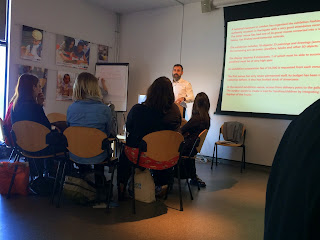My name is Sivan Amar and I am the Registrar &
Production Manager at Tate Liverpool.
I
was very fortunate enough to have been awarded the bursary in order to attend
this fantastic UKRG event, “Let’s Put on a Show!” held in gorgeous Bristol at
the M-Shed museum on 12 May.

I’ve been asked to write a post in response to Kate
Newnham’s,
Curator of Eastern Art and Culture at Bristol’s Museums,
Galleries and Archives, presentation entitled “Porcelain coffee cups and glass
angel wings – Shipping ‘Ahead of the
Curve: New china from China’”. The
talk was aimed at presenting the numerous logistical challenges of planning an international
exhibition of this scope. The exhibition
began as a 4 – 5 year project to be toured to four venues, three in the UK and
one in China (Bristol Museum & Art Gallery, The Potteries Museum & Art
Gallery at Stoke-on-Trent, The Wilson at Cheltenham Art Gallery & Museum,
and Two Cities Gallery in Shaghai). Ms.
Newnham focused on topics: developing funding bids, customs and transport
logistics, working from different cultures, and a set of top tips.
It seemed that the funding bid took the
longest time to develop from 2011 – February 2013. Once the partnership was finally awarded
almost £108,000 in grants from the Art Fund and British Council, the partners
had a mere 6 months to proceed with all the other logistics of planning a
worldwide exhibition. Quite a daunting
task for newcomers to the field of logistics planning! (Surprisingly the exhibition was coordinated
without a Registrar!)

The team found out things in a sort of “chicken vs. egg”
progression, not exactly knowing where to start nor what should come
first.
Several challenges cropped up in
this preliminary logistics stage, all of which are familiar to well-seasoned
Registrars:
the checklist took a long
time to confirm as there were quite a few living Chinese artists who kept
changing their minds or lost the promised artwork, or even gave the work away
as a gift; the language barrier didn’t help anyone; difficulties of working in
with the Chinese government; and internal challenges such as restructuring of
all three UK galleries due to government funding cuts, a co-curator having gone
freelance, and of course, personal events such as marriages, babies, holidays
(it’s always that last category that we all never tend to factor in!)

All things considered, I would have thought that the most
frustrating challenge would have been with the Chinese government.
I could imagine that a country of so many
types of restrictions would not prove helpful when coming to exporting goods overseas.
Crown Fine Art Shippers advised that they would need to apply
for ATA carnet licenses for temporary export of the porcelains, enabling export
for up to 12 months with return to China within that time.
Unfortunately, a requirement of this license
is to pay a deposit of 1/3 of the value of the goods to Chinese customs prior
to export…in cash!
The team obviously
had to scramble to get this cash (as anyone would!), but were very fortunate in
that the Bristol local authority lent the cash to see the exports through.

The team’s next hurdle was deciding on UKGI or commercial
insurance.
Though Ms. Newnham stated
that the Arts Council team is helpful, like most government bodies, they
require time and plenty of information to process a non-national institution’s
application for coverage.
Additionally,
the National Security Advisor had suggested that a courier accompany the
shipping from China in order to ensure safe transport.
This was something the partners could not
afford as they had chosen to ship via seafreight.
Therefore, the partners opted for maritime
insurance with an efficient and tight timetable from the Chinese shippers Yang
Ming.
The sea route aboard the ship
Ubiquity travelled from Shanghai ->
Sri Lanka -> Somalia (no pirates!) -> Mediterranean -> Felix Stowe, UK
-> road transfer to Oxfordshire to Crown UK depot.

Though condition reporting done in China was not to UK
standards, there was sufficient photographic evidence for the team and
conservators to monitor artwork safety upon unpacking in Cheltenham…with some
loo paper thrown in the mix!
However,
some of the crates came packed with beautiful silk lining (sorry Ms. Newnham, I
don’t think this is something everyone can afford to do all the time!)
The exhibition was a success in Cheltanham and Bristol and
continues to impress at each successive venue.
The next challenge will be importing to China, with another
lengthy sea freight trip back home.
Additionally, Ms. Newnham mentioned that Bristol would like to acquire
several of the pieces to add to their renowned glass and pottery
collection. The question for the
Registrars in attendance was how Bristol can acquire the works without having
to forfeit the ATA carnet deposit to the Chinese government. Can they keep the works in the UK under their
NIRU? Can they avoid paying import
tax?

I myself very recently (and painfully) came across this
issue and was able to resolve quite easily with the advise of my shippers.
Because Bristol is a non-profit institution,
they are eligible to have VAT waived on expenses.
Therefore, Bristol will have to pay the VAT
import tax upfront, however once that invoice is issued the shipper will also
automatically issue at C-79 certificate which can be submitted to HMRC to
reclaim VAT on this import.
The
shippers, Bristol financial department, and/or HMRC can certainly advise
further on this point.
If those pieces
Bristol want to acquire are returning to China for the rest of the tour, they
will close out the existing NIRU and receive the full deposit back from Chinese
customs, but they’ll have to ship the works again.
Either way, they are going to have additional
costs.
Perhaps these can be covered by
the acquisition funding?

As I had mentioned earlier, I was very surprised and a bit
upset that a Registrar did not oversee a project of this scope.
I spoke with Ms. Newnham after her
presentation, who stated that the Bristol Museum & Art Gallery does have a
Registrar but due to her workload she was unable to work on this
exhibition.
What upset me about this was
that the job of a Registrar was in this case delegated to a curator.
Though the team successfully handled the
project, it might have gone smoother had an expert been appointed to deal with
the issues they came across.
When Ms.
Newnham talked about the funding bid and finalizing budgets for the project, I
wonder if a freelance Registrar could have been factored in?
This might have been thought of at the time
but then had to be budgeted out, however I cannot stress the importance of a
Registrar as expert in shipping, logistics, contractual, insurance, and art
handling matters.
With the task of
return shipping back to China, I would recommend a Registrar be employed for
the job to ensure all documents, etc are in order (I absolutely fell in love
with Bristol, so I’m happy to sign up for the job!).



